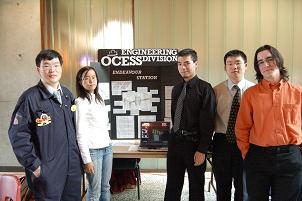University of Toronto Space Design Contest
The University of Toronto Space Design Contest (UTSDC) is a competition hosted by a group of volunteers at the University of Toronto. Its purpose is to challenge teams of up to five to design a space-related system such as a lunar base or space station. The competition is adjudicated in two categories: Junior (Gr. 7-10) and Senior (Gr. 11-12), and winning submissions are added to the UTSDC-verse, which is a fictionalised extension of reality beginning in 2050 and continuing with the construction of the facilities proposed in aforementioned winning submissions.
The OCESS has participated three and a half times in the UTSDC and its various teams have won such awards as second and third places as well as best technical report. This participation is one of the factors that led the University of Toronto to sponsor the Galileo Challenge.
UTSDC veterans have frequently expressed the opinion that Spacesim should always participate in the contest even when they do not feel they have a chance of winning, because it is an incredible networking and educational opportunity. The contest has incredible access to actual researchers in the space science field, including tours of the University of Toronto Institute for Aerospace Studies as well as a huge multitude of brilliant guest speakers. In 2009-10 at UTSDC, Lyra Evans got to drive a lunar rover that was 4,000 km away, while Samuel Baltz would have had he realized that metres were not the same thing as kilometres.
Point Five
In 2005-06 Mission Commanders Stephen Smith and Crystal Xiao attempted several times to form a UTSDC team, but ultimately failed to recruit any interested members. They did send away to the competition, however, voicing their hope that the OCESS might be permitted to participate in the future and expressing their desire, as student-led space-oriented organizations, to work together in some form in the future. The UTSDC responded by sending a letter expressing similar sentiments as well as a box of competition T-shirts.
2007 Contest


In 2006-07 the OCESS UTSDC team led by then Mission Commander Brian Foo won second place overall. Their space-hotel, Endeavor, was also selected as the best technical report of the competition.
While in Toronto, team members enjoyed a tour of the university and its affiliated aerospace engineering facilities (UTIAS). They were then fortunate to be treated to an additional tour of the UTIAS space flight laboratory by spacesim alumnus and former Mission Commander Daniel Kekez, who is currently employed at UTIAS.
The 2007 team members were Brian Foo, Stefan De Young, Alex Foo, Jonathan Scothorn, and Guangye Cao.
Networking
After the 2007 team's success, then EEP Commander Jeff Gao used the access to the University of Toronto gained by his fellow spacesim members in order to negotiate a partnership with the University to ensure province-wide distribution of the Galileo Challenge.
2008 Contest
In 2008 the OCESS assembled a team to compete in the Senior category. The members of the 2008 team were Anthony Xing, Ben Paul, Daisy Wong, Maclean Rouble, and Arthur Quang. Their task was to design an Emergency Response System for the fledgling space infrastructure currently in existence in the fictional time line that all UTSDC projects follow. The competition was held on May 15-18, where the OCESS team gained third place. Mr. Paul, unfortunately, was unable to attend.
2009 Contest
In 2009 OCESS again competed in the Senior challenge, this year to create a training facility for young astronauts. Although Daisy Wong, Maclean Rouble, Ben Paul and Matt Farkas-Dyck contributed a fine project, they did not gain a prize, perhaps due to organizational issues caused by Maclean's absence in Belgium for the months preceding the report due date.
2010 Contest
In 2010 OCESS once again competed in the Senior challenge, this year with two separate teams. The first team consisted of Maclean Rouble, Ben Paul, Ian Martin and Amalissa Hum, while the second team consisted of Lyra Evans, Samuel Baltz, Rutger Theodoor Ronald Jansen van Doorn Campbell, Peter Macdonald, and Yvonne Ho. The challenge was to protect the Earth from an incoming Near Earth Object, without any form of explosives. Neither team placed, due to their individual extraordinary lack of organization. The first team handed in their proposal a month after the deadline after receiving an extension due to Matthew Farkas-Dyck leaving the team at the last minute and UTSDC not sending all the information. The second team's proposal was written entirely by Samuel Baltz and Lyra Evans, who also required two extensions. The late proposals automatically ruled the teams out of consideration because they missed the proposals judging contest; this is a valuable lesson for future years.